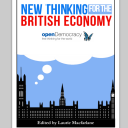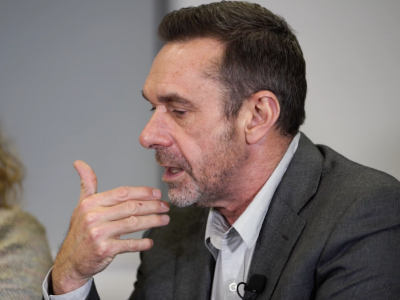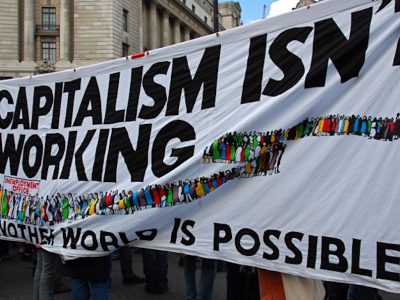Neoliberalism has destroyed social mobility. Together we must rebuild it

Image: Jacqui Brown, CC BY-SA 2.0
In his first monthly column for openDemocracy, Paul Mason argues that the mission of radical social democracy must be to rekindle hope in a simple idea: that life in your community will get better. Next week Paul will discuss the issues raised in this essay at a roundtable discussion hosted by openDemocracy at Goldsmiths, University of London. A video of the event will be released shortly after.
The earliest picture I have of my Dad, John, is a class photo at primary school, sometime around 1936. He is clearly one of the poorest kids in the school and one of the most sickly: deaf in one ear, stick thin, small for his age, struggling to smile.
When I look at my favourite picture of him, on a beach at Newquay in the 1960s, he is happy, healthy and doing OK: a lorry driver who can sight-read and sight-transpose music, and discuss the ideas of EP Thompson and Solzhenitsyn.
His income had risen steadily in the post-war decades. But his life had been transformed. The technical term for what happened to him is intra-generational upward social mobility. But it does not even begin to capture the upswing in mood, quality of life, confidence and freedom of action that his generation experienced.
During the Depression, my dad used to cling to his mother’s knees to stop her answering the door, in case it was bailiffs coming to take their furniture. Furniture you could do without; the self-esteem that went out of the door with it, to be replaced by cold humiliation, was a different thing.
Today, the ghosts of my Dad’s childhood are back. Massively indebted households; poverty deep enough for food handouts to matter; rampant domestic violence; housing insecurity, and far-right xenophobic politics. All these are symptoms of a deeper problem which has made the idea of upward mobility in your lifetime feel impossible to many working class people and – equally important – made the fear of a downward plunge distinctly rational.
The post-war Labour government of Clement Attlee met the aspirations of my Dad’s generation so exactly that it was the political equivalent of throwing a treble 20 at darts. It made, both at the time and in their memories, a satisfying clunk.
Labour under Attlee was able to transform British capitalism irreversibly because they understood: what they needed to do, who to do it for, in what order, what the risks were, and how to overcome the resistance.
Labour under Jeremy Corbyn has clawed its way to just above 40% in the polls because it has answered some of these questions; it will get to form a majority government when it answers all of them. The same lesson holds for other would-be transformative left governments across the world.
The what, the who for, the sequencing and the mitigation of risk will the subject of this essay series for openDemocracy on what radical social democracy means during the next decade.
***
What’s the problem we are trying to fix? It was described clearly by Jeremy Corbyn in his speech to the European Social Democrats’ conference in Brussels in October: “the neoliberal economic model is broken”.
That model, like all paradigms within industrial capitalism, had a beginning, middle and an end. In a brilliant confirmation of the dialectic, the same factors that drove neoliberalism’s upswing also caused its downswing.
Globalisation expanded the world’s workforce and delivered gains from trade way in excess of any previous period of international open-ness. Smashing the power of organized labour allowed a historic global reversal of labour’s previously rising share of GDP. The globalization of finance allowed household and corporate debt to grow, apparently, without destabilizing the system.
But from the mid-1990s onwards capitalism began to regurgitate capital. From the Asian crisis, to the Russian crisis, to Long Term Capital Management and then the dotcom crash of 2000-2001 a pattern emerged: an excess of capital compared to real growth and productivity.
With the wage share depressed, consumption had to be driven by credit, forcing large numbers of people to believe they had a stake in the financialisation of everyday life.
The pattern between the mid-1990s and 2008 is repetitive: capital floods into the financial sector triggering a boom-bust cycle; central banks respond by creating more money; this floods into a new asset class or country or region – triggering a renewed financial boom and bust cycle.
If, in the meantime, the information technology revolution had delivered what it promised – high productivity, high wages and high growth – this speculative frenzy might have ended with a new take-off of capitalism. The problem is: information technology is real but its value-producing properties are over-estimated. It produces increased usefulness but collapses the price of everything, above all itself.
According to the Bank of England’s economists Rachel Lukasz and Thomas Smith, out of an average global growth rate of 3-4% per year, technological innovation is responsible for precisely minus 0.2 percentage points over the past 30 years.
If you look at the positive drivers of growth identified by the Bank’s economists during the neoliberal era, they reach an inflexion point somewhere around the year 2000. In the 1980s and early 1990s about half the growth comes from the expanded global labour supply and half from “growth at the frontier of productivity”: that is rising education levels, falling inequality and the long term fiscal expansion that had pushed global government debts up to 60% of GDP by around 2000.
But from around the turn of the century global productivity growth disappears, to be replaced by “catch-up growth”: poorer countries industrializing their economies, urbanizing their populations and moving into the services sector. The price is massive financial, trade and fiscal imbalances which can only be reversed through a devastating financial crisis. Paying for that crisis boosts global government debt above 90% of GDP and has left the entire world economy dependent on monetary life support.
The problem is that over the next 30 years the Bank’s economists predict that catch up growth will peter out; growth in the global workforce will be slower; fiscal expansion from a base of 93% of global GDP will be very difficult; and tech-driven productivity is nowhere.
Their projections accord with the view of Larry Summers, the former US Treasury Secretary, who wrote in 2014:
“the difficulty that has arisen in recent years in achieving adequate growth has been present for a long time, but has been masked by unsustainable finances.”
If he is right, then the brutal conclusion we have to draw is that neoliberalism was not a solution to the problems of Keynesian system: it was a work-around.
The essential problem my Dad’s generation faced after 1973 – declining productivity and rising state spending – has not been solved by globalisation, or by vastly inflating the finance system with cheap money. It was just shoved to one side.
Unless it could go on expanding private debt and the money supply forever, sooner or later the neoliberal model was going to hit the wall just as Keynesianism did. That’s what happened in 2008. The system ran on empty until 2016 and then with Trump and Brexit the multilateral global framework began to fragment. Elites all over the world discovered that human brains cannot run on empty: they need a coherent story and the neoliberal model no longer tells one.
The implications of this for social democracy should be obvious. It means you can’t replace neoliberalism with a return to the Keynesian model. It, too, was broken. The assumption of many activists on the Labour left – that if only we could nationalise more, tax more, write better industrial strategies, upskill more people, build more infrastructure and homes, we would come out with a working model of capitalism – is wrong.
Likewise – from the Bernie Sanders movement in the USA to the Left Party in Germany – the illusion that working class discontent with globalization can be fixed by offering people over 50 a return to the economics of their childhood is also false.
In power the left will have to use tools and techniques borrowed both from the Keynesian era and from the neoliberal era, but its aim must be to design a model that is different from both – with an emphasis on modelling over planning; mixed ownership models rather than straight nationalisation, massive decarbonisation, and the proactive creation of a collaborative sector – using open source software and non-profit production.
And because all governments exist within in a highly connected global system, we will have to take a lot more people with us: foreign investors, foreign governments, foreign exchange markets.
A Labour government led by Corbyn, and committed to measures similar to those of the 2017 manifesto, would take its first steps amid resistance. It would come from an almost totally hostile press – whose job would be continuous de-stabilisation through misinformation; from those parts of the London finance sector that have made the City a playground for every crook and tax dodger in the world; and from a small but viscerally reactionary section of the population influenced by the international far right, from which Jo Cox’s murderer, the alleged Finsbury Mosque attacker and the five soldiers accused of neo-Nazism were all drawn.
Against each of these adversaries, a left-wing Labour government has to deploy the powerful weapon of hope. Not long-term hope, but the short-term promise and delivery cycle that saw my Dad’s pit nationalised and healthcare made free within two years of Labour’s election victory.
The aim of a radical left government in Britain should, over a five- to ten-year period, establish a new dynamic to drive economic growth, which replaces the broken dynamic of neoliberalism.
That means: replace growth driven by asset price inflation with growth driven by productivity. If, in the process, it has to rely on growth driven by expanding the workforce or catch-up growth with more advanced economies, or even further monetary expansion, it shouldn’t flinch from that. But Labour will have to wean consumers off cheap money; wean the elite off tax evasion and rent-seeking; wean entrepreneurs off the creation of low-wage, low value businesses; and wean the private sector off reliance on outsourcing and on rent-seeking activities like PFI.
That, in one paragraph, should describe Labour’s economic strategy. People who think John McDonnell’s fiscal policy – essentially a £50 billion redistributive tax plan plus £250 billion borrowing – amounts to an economic strategy are mistaken. These are simply the fiscal conditions for beginning a much wider transformation project.
And that transformation project has to be defined around a social goal. Labour has to use the extra money, together with micro-level reforms to company law and business regulation, radically changed outsourcing rules and a limited nationalisation programme. I will explore the options in a later essay, but the basic aim is to achieve two things:
- Tangible and rapid improvement in the real pay, housing costs and public service quality for working age adults on middle and low incomes.
- The revival of towns, estates and communities whose economies have had the heart ripped out of them.
This means rethinking the very concept of social mobility.
So cynical have people become during this fag-end era of neoliberalism that, on the left and among community activists, it is becoming common to hear the very idea of social mobility decried as “elitist” – as if it is always for someone else.
Since Thatcherism, it’s become a code word for the “aspirational voter” – someone who wants to escape poverty by stabbing everyone else in the back and leaving them behind; someone who wants to scale the class hierarchy even as the gaps between rich and poor widen.
For my Dad’s generation, it meant something different. It meant being able to do well by working hard, while seeing your town, your community, its built environment and its commercial vibrancy rise with you.
So we need to start defining social mobility in terms of people and place. Before they resigned in frustration at Theresa May’s negligence, the government’s Social Mobility Commission produced 16 criteria against which to state the bleeding obvious: that rural areas, coastal areas and old industrial areas are seeing conventionally defined social mobility stagnate.
But only five of their criteria concerned adult life – and these criteria were almost always static: the level of the average wage, the number of homeowners, the number of managers and professionals in an area.
At best, the official social statistics of the Tories’ now-abandoned social mobility project reflected the “value added” by schools and nurseries – not changes in the life chances of adults. The subtext was that the best you can hope for in an era of wage stagnation is that the next generation escapes their parents’ no-hope towns and dead-end jobs via the education system.
This is not good enough.
If instead, the Social Mobility Commission had measured changes in the value of take-home pay, in leisure time, in the quality and speed of public transport and the affordability of housing they would, in many areas, be recording a big reversal. And that’s even before you start considering the intangibles like how safe or how crime-ridden does an area feel, how dead or vibrant the high street, or simply whether there’s an atmosphere of hope.
In 1962 the urban theorist Charles Stokes divided the world’s informal settlements into “slums of hope” and “slums of despair”. Though no government has dared apply these categories to British towns, their inhabitants subconsciously do so.
Labour’s economic policy has to be framed in a way that offers all adults at or below the median wage the believable possibility that their real pay will rise; their housing costs fall and the quality of their environment will improve. Whereas post-war governments targeted bomb damage, slum clearance and areas of extreme privation, today it is the “town of despair”, to borrow Stokes’ phrase, that should be highest on the rescue list.
One of the first things Labour needs to do is frame new metrics that will force civil servants, local councils and outsourcing contractors to judge their success or failure against these goals – and to scrap the market metrics which have been coercively applied to the public sector to justify rip-off outsourcing and PFI contracts.
People must see a future where wages rise, instead of stagnating; where servicing their debts does not swallow half their salaries; where life in towns and cities becomes easier; where the basic amenities of life become cheaper; where there is a rich and vibrant cultural life.
An important part of this story is about restoring people’s belief in public services. That means not just funding the health service, reversing cuts to education and local government but uncapping public sector pay; creating salary structures and rewarding career paths for the millions of people who work in public services; space to innovate in public service, not just to survive the week.
For all this, you need money. Labour’s 2017 manifesto promised to raise £50 billion in taxes from corporations, property speculators and high earners to fund NHS and education spending, the beginnings of a Nordic childcare system and free university education. It was the right thing to do but it is not the whole solution. That £50 billion pushed at the limits of what can be raised in a stressed economy like Britain’s.
Far more important is the £250 billion Labour has promised to borrow and spend via a state investment bank. The next time Labour goes into an election it needs to concretise how, when and where that £250 billion would be spent. Every school needs to know how much of that money it can expect; every local Labour party needs to be asked for a wish list of what their town needs.
From the conversations I had on the doorstep around the general election in 2017, my guess is that the local demand will rarely consist only of new motorways and railway lines. I had primed myself for a Brexit backlash, but even in the classic pro-Leave communities the first encounter usually involved a person pointing angrily over my shoulder at a hole in the road and asking simply: when will this get filled?
People want the fabric of their local communities restored: youth clubs, adult social services, mental health facilities, green space and thriving high streets.
One of the most depressing things about the narrative of neoliberalism was its insistence that old communities must be disrupted, their facilities allowed to rot, so that shiny palaces of uninhabited luxury flats could be built next to them. That the pubs must close so that the high streets of small towns could become lined with shops selling alcohol for consumption at home.
Labour in power has to defy the idea that public spending on skills, human capital, the urban environment and culture is somehow “not investment”. I would like to see significant amounts of that borrowed £250 billion go into human capital and urban renewal. We’re short of nurses, doctors, home care workers; we’re short of people who can design and virtually manufacture aircraft; we’re short of recruits to the armed forces. Invest in that.
But even £250 billion may not be enough to kick-start the investment needed to restore dynamism to those areas of Britain that time – and successive governments – seem to have forgotten. That’s why a Labour government should maintain and even expand quantitative easing, and broaden the scope of what the printed money can be spent on. The aim should be – as Bank of England Governor Mark Carney himself suggested at Shanghai in February 2016 – to create a bridge to the future economic model, not a “pier” that ends up nowhere.
Any government that did what I am suggesting would be an outlier in the global system. It would meet domestic and external resistance and I will discuss in a later essay how this resistance could be overcome.
But I want to finish where I started. For my Dad’s generation, the ideas of Edward Thompson and Alexander Solzhenitsyn were – beyond the complexities – distinct signifiers. Thompson taught them that the British working class has a story, and that what Labour did after 1945, and Wilson in the 1960s, was designed to achieve progress for them before anyone else. Solzhenitsyn taught them that, if there was an alternative to capitalism, if could not be the abhorrent and inhuman forced march to planned scarcity we saw in the USSR.
When they smashed my Dad’s generation of trade unionists, and subjected them once again to the humiliation of mass unemployment, the aim of the neoliberals was not simply to defeat them, but to eradicate the idea that there might be something better than the coercive, monopolized, almost penal free market system that was then imposed.
In that sense, Thompson’s history of the working class and Solzhenitsyn’s revelations about Russia shaped the framework of the social democracy I grew up in much more clearly than, say, the writings of Labour intellectuals like Anthony Crosland.
With the industrial society I grew up in long gone, this battle for a cultural narrative is going to be harder for radical social democracy, but not impossible.
To get significantly beyond its current 40% poll ratings, Labour has to punch through into two demographics that are not yet excited by the prospect of Corbyn in power: firstly, the left-behind, impoverished and sometimes bitter people from my Dad’s generation who see de-industrialisation and high migration as the reason social mobility has disappeared. And secondly, a class of private-sector employed professionals; people happier voting Tory or Liberal Democrat, but increasingly concerned at the rising costs of their kids’ education and their parents’ social care.
The Attlee governments have been mythologized. Everybody wants to remember Bevan founding the NHS, but few know or care that Labour’s chancellor Stafford Cripps once slapped a 95% tax on the super-rich, proudly telling the TUC in 1948 that only 70 people in the country were capable of luxury spending.
And while everyone knows the post-war Labour government built houses, how many understand how vital it was that these were high-quality, low-rent properties offering tenancies for life, not insecure shoeboxes built as an afterthought to luxury developments?
Neoliberalism turned social mobility into a game of snakes and ladders – with even people on middle incomes worried that redundancy, offshoring or the insolvency of a major contractor like Carillion can plunge them several rungs down the ladder.
By implementing the Beveridge Report, and creating a nigh-impenetrable social safety net, the Labour government banished that fear for a generation.
Attlee’s 1945 manifesto gave my 18-year old Dad, in his first year down Astley Green Colliery, something positive to say both to the older generation, who believed nothing could change, and to middle class voters wary of a radical break. Its last lines contain an appeal to “all men and women of progressive outlook, and who believe in constructive change, to support the Labour Party”.
Labour’s message needs to be just as clear. Alexis Tsipras may have failed in his attempt to break Greece out of its EU-imposed austerity in 2015. But his slogan – “Hope is Coming” – sums up perfectly the message Labour and the other emerging forces of the left has to deliver to voters.
John McDonnell’s fiscal policy in 2017 acted like an electrical charge for voters in many working class communities; next time Labour needs something a lot more concrete.
People will believe “hope is coming” when they know that money, investment, decent jobs and better services are coming – not just to their town or region but to their street and postcode.
Next week Paul will discuss the issues raised in this essay at a roundtable discussion hosted by openDemocracy at Goldsmiths, University of London. A video of the event will be released shortly after.








